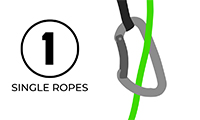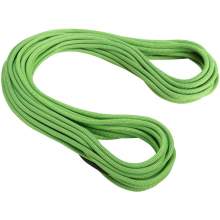8.7mm Serenity 60m 2xDry
Description
Triple-certified high-end rope for sports and alpine climbing at the highest level! With a diameter of 8.7 mm and weighing only 51 g/m the 8.7 Serenity is one of the thinnest and lightest single ropes. The high sheath proportion also makes it the most durable rope in its class.
Retail price
This Product is Hard to Find.
We don’t know where you can buy this item online in the US. We’ll continue to check all the major retailers and will update this page as soon as we find one.
If you know where to find this online in the US, let us know, and we’ll add the link.

| Weight | 51.0 g/m 6.746 lbs / 3060 g |
| Diameter (millimeters) | 8.7 mm |
| Length (meters) | 60 m |
Rope Type  Type
There are 3 types of dynamic ropes that are used by climbers. They are known as Single, Half (Double), and Twin. The type of rope preferred varies by climbing style, location, and region. Single
By far, the most common type of rope. Great for indoors and out. In the US, it is the most common sport and big wall and are also used for trad cragging. The handling is simple and the diameter options are quite varied. Half (Double)
The best cure for a meandering route, only one of the ropes will clip into each piece of protection so a mindful climber can can reduce rope drag considerably. You can also rappel twice the distance, it’s easier to safely protect traverse pitches and there is a smaller chance that both ropes would become damaged (by rockfall, crampons, etc). Twin
Both ropes must be clipped through each piece of protection. This is the lightest style of (two) ropes. They excel for rappels, going twice the distance vs a single rope, but do not have the ability to mitigate rope drag even though there are two ropes. It is unlikely both ropes will be damaged at once, and is why many alpine, ice and mixed climbers choose twin and/or half ropes. Learn More
Every rope type and when to use them | Single/Half/Twin |
UIAA Falls (Single / Half / Twin)  UIAA FallsThis refers to the number of UIAA falls a rope has been tested to be able to withstand without breaking. The UIAA fall is a complicated test that is designed to create a uniform standard for strength in ropes, and is not generally reflective of real-world climbing situations. The test involves dropping a weight tied to the rope in such a way that it will see the highest amount of force a real-world situation could generate. The UIAA requires that Single and Half ropes must pass this test without breaking at least 5 times, while twin ropes must withstand 12 falls. In practice, it can likely be concluded that ropes that have higher than this standard number of falls will be stronger and put up with more abuse. It is important to note that any rope that is UIAA or EN certified is considered safe to climb on, regardless of the number of UIAA falls it is rated for. | 5 falls / 17 falls / 20 falls |
Dynamic Elongation (Single / Half / Twin)  Dynamic ElongationThis refers to the amount of stretch measured during the dynamic testing (or drop test) used when certifying ropes. Higher stretch will absorb more force and result in a softer catch but increases chances of groundfall at the beginning of a climb. The EN and UIAA require a stretch of at least 10% and no more than 40% for dynamic ropes. Single and Half ropes are tested individually and Twin ropes are tested as a pair. | 31.0 % / - / - |
Static Elongation (Single / Half / Twin)  Static ElongationThis refers to the amount of stretch measured during the static test used when certifying ropes. Most climbers will notice the difference in static elongation when climbing in a top rope situation, where higher stretch will make for a springier belay and could result in a ground fall when climbing closer to the ground. The EN and UIAA require a stretch of no more than 10% for Single and Twin ropes and no more than 12% for Half ropes. Single and Half ropes are tested individually and Twin ropes are tested as a pair. | 6.0 % / - / - |
Impact Force (Single / Half / Twin)  Impact ForceImpact force is the amount of force in kN that is measured at the testing mass during the UIAA dynamic drop rope test. When the weight is dropped, the force measured must be at or below 12kN for Single and Twin ropes and 8kN for Half ropes. The real world application of this test is determining that the rope can dissipate and absorb the appropriate amount of force from the fall as it would be felt by the climber. The variables used in the test set a situation that is well beyond anything climbers encounter, and shouldn't be considered realistic to actual climbing situations. In reality forces of this magnitude would result in severe injury as this test is designed to test the limits of the rope and not the comfort of the climber. | 8.10 kN / 6.30 kN / 9.70 kN |
Dry Treatment  Dry TreatmentWhen a rope is dry treated, it has had a coating applied to its core fibers, its sheath fibers, or both. The purpose of this coating is to reduce the amount of water the rope can absorb when in wet or icy conditions. Wet ropes are heavier, handle and belay differently, and have been tested to be weaker than dry ropes. Many climbers prefer dry treated ropes for very dusty or dirty environments, as they are more resistant to uptake of dirt and can stay cleaner longer. Learn More
Benefits of Dry vs Non-Dry ropes | Sheath & Core |
| Sheath Proportion (%) | 36.0 % |
| Sheath Slippage (mm) | 0 mm |
| Type of Middle Mark | None |
| Rope End Marker | None |
| Certification | CE, EN, UIAA |
RFID / NFC Option  RFID and NCFThis technology can be helpful if you are a gym or professional business where you'd like to track the usage and age of your ropes. RFID is how items are uniquely identified using radio waves (Radio Frequency Identification). It's for 1-way communication from 10cm to 100m away depending on the frequency. Example: Airport Baggage. NFC is a subset of RFID that is restrained to close proximity communication typically less than 10cm (Near Field Communication). NFC chips can operate a 2-way signal to exchange information. Example: Apple Pay. | None |
No reviews yet.
Though it's true that the Serenity is applicable for all types of climbing, I still consider it a specialty cord. (Mammut states the Serenity is ideal for sport climbing, alpine climbing, comp climbing, mixed and ice climbing and multipitch climbing.) I wouldn't want to fall on it, on lead or when following, on Eldo's rough, sharp sandstone. The thought of the slinky line rolling over sharp edges and through loose rock gives me an uneasy feeling. For hard adventure climbing on loose terrain, I'll stick to a thicker cord every time, even if just for the piece of mind.
So there is lots to think about and the Serenity would never be my choice for climbing on rough gritstone or certain other high friction rock types. I also wouldn't bother choosing it when a short walk in means I don't need the pack ability or weight saving they offer. However, when faced with a heavy pack, a full on mountain day or a long walk in, the Serenity is worth every penny and the Serenity is currently my first choice for both personal and professional use on long multi-pitch and mountain routes. I have also found the Serenity lasts well if managed carefully and the rope is a dream to handle providing the thin diameter is factored in. Well done to Mammut for producing another innovative and high quality product. So, if your budget allows and the rope suits your requirements, I would really give the Mammut Serenity a close look. You won't be disappointed.
Performance: We refer to ropes as “buttery” when they’re lightweight, supple, and easy to clip, and the Serenity embodied this. One guide tester chose this cord over his 12 others time and time again. It’s the thinnest and lightest (51 g/m, so 6.8 lbs. for 60 meters) single rope that our testers have climbed on; they used it at crags like American Fork, Utah, and alpine-heaven Mt. Whitney in California, where they praised it for not adding considerable weight to already-overloaded packs. One tester was hesitant about the diameter at first, but he quickly gained confidence after watching the rope rake over granite, sandstone, and rough limestone with no signs of wear or fuzz. Mammut’s Coating finish protected from abrasion, moisture, and dirt, which is the true rope killer.
Drawback: It’s not technically approved for use in some belay devices, including the Petzl Grigri 2 (designed only for ropes from 8.9 to 11mm), but testers found that the Grigri 2 still bit down on the cord, with no slippage during belaying, taking, or falling. Still, the belayer should be attentive at all times. Bonus: This rope is certified as a half and twin rope, too.
This video talks about the Mammut 2015 rope line.
This video shows all the features of Mammut ropes.






